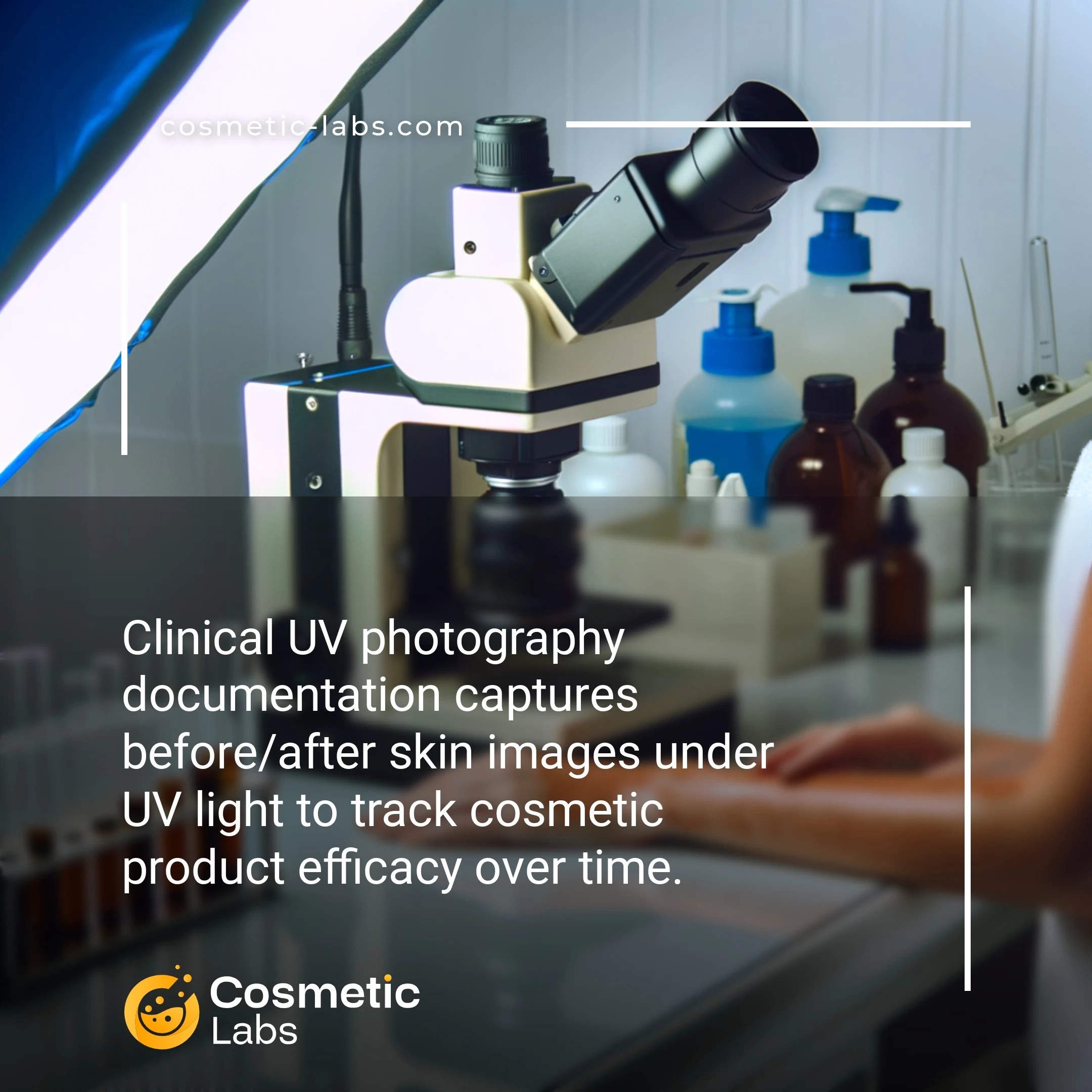Clinical UV Photography Documentation for Cosmetic Testing

What is Clinical UV photography documentation?
Clinical UV photography documentation services capture standardized before-and-after images using specialized ultraviolet lighting to reveal skin changes invisible to the naked eye. These controlled imaging protocols document product efficacy for cosmetic brands by photographing test subjects under consistent UV conditions, typically at 365nm wavelength, to track improvements in sun damage, pigmentation, and skin texture over time. The standardized lighting eliminates variables that compromise traditional photography, providing regulatory-grade visual evidence for marketing claims and clinical studies.
Why do you need this service?
Cosmetic labs use clinical UV photography documentation to track photoaging effects during sunscreen and anti-aging product testing, capturing before-and-after images that reveal UV damage invisible to standard photography. This specialized imaging helps brands validate SPF claims and demonstrate product efficacy by showing measurable improvements in skin texture and pigmentation over 4-12 week testing periods.
Who provides Clinical UV photography documentation services?
All cosmetic labs providing Clinical UV photography documentation services
There is no company providing these services at the moment.
Clinical UV Photography Documentation Services
Clinical UV photography documentation captures detailed before-and-after images under controlled ultraviolet light conditions to track cosmetic product efficacy and skin changes over time. These specialized imaging services provide the visual evidence needed for regulatory submissions, marketing claims, and clinical study reports.
UV Imaging Protocols and Equipment Standards
Professional labs use standardized UV photography equipment with specific wavelength filters to reveal subsurface skin conditions invisible to standard photography. The imaging process follows strict protocols for lighting, positioning, and camera settings to ensure reproducible results across multiple sessions.
Key documentation elements include:
- Baseline UV images before product application
- Sequential progress photos at predetermined intervals
- Standardized subject positioning and lighting conditions
- Digital image analysis and measurement tools
Labs typically schedule imaging sessions at 2, 4, 8, and 12-week intervals depending on your study design requirements.
Regulatory Compliance and Data Management
UV photography documentation must meet FDA and international regulatory standards for clinical trial evidence. Labs maintain detailed chain-of-custody records, subject consent forms, and image metadata to support regulatory submissions and efficacy claims.
Documentation packages include:
- Calibrated equipment certificates and maintenance logs
- Standard operating procedures for image capture
- Subject identification and tracking systems
- Secure digital storage with backup protocols
Professional labs store images in HIPAA-compliant systems with controlled access for authorized personnel only. Connect with experienced clinical documentation labs on our platform to discuss your UV photography requirements and timeline.
Practical Applications of Clinical UV Photography Documentation
Cosmetic brands rely on clinical UV photography documentation services to validate product claims, support regulatory submissions, and build consumer trust through visual evidence of treatment outcomes.
Product Efficacy Validation and Claims Support
Labs capture standardized UV photographs at baseline, 4-week, 8-week, and 12-week intervals to document changes in skin pigmentation, sun damage, and photodamage. These images reveal subsurface melanin patterns invisible to standard photography, providing objective evidence for anti-aging and brightening product claims.
The documentation includes quantitative analysis of pigmentation changes using specialized software that measures melanin density and distribution patterns. This data supports marketing claims about dark spot reduction, evening skin tone, and UV damage repair with measurable percentage improvements.
Regulatory Compliance and Clinical Trial Documentation
Regulatory agencies require photographic evidence for certain cosmetic claims, particularly those related to skin lightening or sun protection efficacy. Labs maintain standardized protocols using controlled lighting conditions, consistent camera settings, and identical subject positioning across all documentation sessions.
The resulting image archives meet FDA and international regulatory standards for clinical trial documentation. Each photograph includes metadata showing exposure settings, lighting specifications, and calibration data to ensure reproducibility and scientific validity.
| Documentation Type | Imaging Schedule | Key Measurements | Regulatory Use |
|---|---|---|---|
| Pigmentation Analysis | Baseline, 4, 8, 12 weeks | Melanin density, spot count | Brightening claims |
| Photodamage Assessment | Baseline, 8, 16 weeks | UV damage patterns, texture | Anti-aging claims |
| Sun Protection Efficacy | Pre/post UV exposure | Erythema response, pigmentation | SPF validation |
Connect with qualified cosmetic labs on our platform to access professional clinical UV photography documentation services that meet your specific product validation and regulatory requirements.
